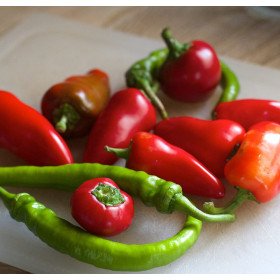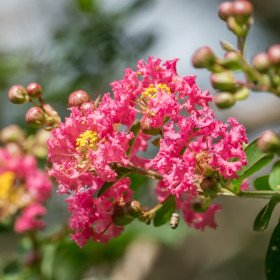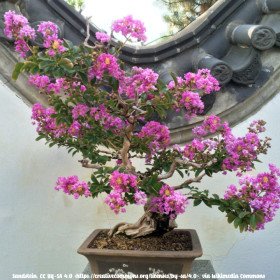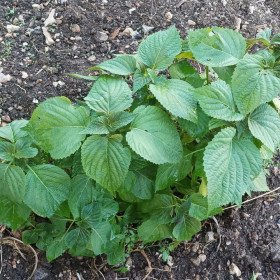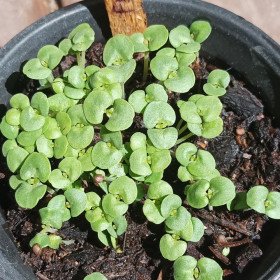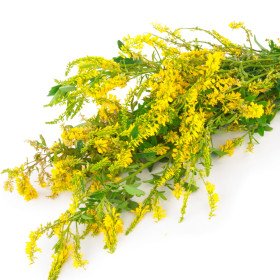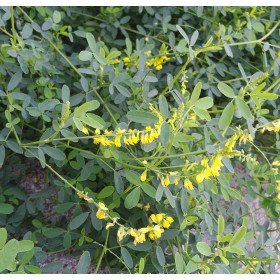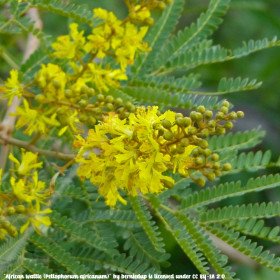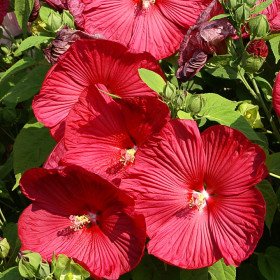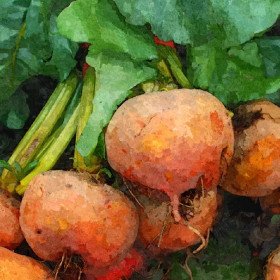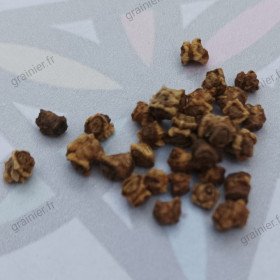5 Graines Concombre/Melon amer, Margose, Momordica charantia
5 Graines Concombre/Melon amer, Margose, Momordica charantia
- Modèle : 5 Graines Concombre/Melon amer, Margose, Momordica charantia
- Disponibilité : INDISPONIBLE
- 1,50€
Me contacter dès que le produit est disponible
Concombre/Melon amer, Margose, Momordica charantia |
La margose, melon amer ou momordique (Momordica charantia), est une plante potagère grimpante de la famille des Cucurbitaceae, cultivée dans les climats chauds ou tempérés en plante annuelle. Le terme margose désigne la plante et le fruit, la plante est parfois nommée improprement margosier qui désigne en créole de l'Océan indien le mélia (Melia azedarach. L)1. Le fruit, la feuille et les graines sont comestibles et amers (le mucilage rouge qui entoure la graine est la seule partie douce de la plante). Cette amertume provient des momordicines, substances proches de la quinine. La margose est connue pour ses qualités culinaires et pour ses propriétés thérapeutiques en médecine traditionnelle, notamment dans le traitement du diabète et de certains cancers.
5 Graines - semis direct
Cette espèce se présente comme une plante annuelle grimpante et tapissante dont la hauteur peut atteindre 5 m. Les tiges sont délicates et munies de vrilles simples. Les racines peuvent présenter des nodosités.
Les feuilles alternes sont de forme comparable aux feuilles de vigne, les limbes ont 3, 5 ou 7 lobes. Les feuilles ont une forte odeur et ont un goût amer.
Les fleurs sont petites et jaunâtres, portées par des pédoncules frêles. Les fleurs mâles ont trois étamines et les fleurs femelles ont un stigmate à trois lobes et un ovaire infère.
Selon les cultivars, la surface des fruits est plus ou moins tuberculée, leurs longueurs varient de 8 à 35 cm.
À maturité le fruit est orange lumineux et se divise du bas vers le haut en 2 ou 3 segments qui laissent voir les graines dans leur mucilage rouge, transparent et gélatineux. Le fruit est décoratif, mais répand rapidement ses graines.
La culture demande des températures comprises entre 24 et 35 °C, un sol frais, mais non détrempé, une altitude inférieure à 1 700 m. Le forçage des jeunes plants en milieu protégé est conseillé en climat tempéré. La floraison intervient deux mois après le semis. Au-delà de 14 heures de jour la floraison est ralentie. La fructification peut être prolongée jusqu'à 6 mois par une récolte régulière des fruits verts. Elle serait quasiment indifférente à la longueur du jour37.
En culture, on prévoit un tuteurage à 2,5 m avec filet et une plante tous les 50 cm. La paillage permet de tenir le sol humide. La fertilisation doit être riche en azote et prévenir la carence en bore à laquelle la margose est sensible. Des apports de micronutriments sont favorables à la croissance et la fructification, une pulvérisation foliaire de ZnSO4+ FeSO4+ MgSO4 en solution à 0,5 %, 35 et 45 jours après le semis a été expérimentée avec succès38 en 2017. Une étude roumaine démontre que la conduite de la plante sur 2 branches augmente la production et la précocité des fruits29.
Un sol couvert de paillis favorise une récolte abondante et de bonne qualité, plus précoce d'une semaine avec un paillis plastique. Une meilleure humidité du sol est observée sous paillis plastique ou sous paillis minéral, d'après une comparaison de paillis systématique indienne (2018)39. En hydroponie, les substrats perlite + vermiculite et vermiculite + fibre de coco donnent les meilleurs rendements40.
Les maladies fongiques (fusarium, mildiou et oïdium) causent des dommages, les virus (Geminiviridae, virus mosaïques…) également, ainsi que le flétrissement bactérien. 3 gènes de résistance à l'oïdium ont été identifiés en 202141.
En climat tropical, la mouche du melon est avec les pucerons le principal ravageur. En climat tempéré chaud, la culture est facile pour autant que la température plafond n'est pas dépassée.
Contenu soumis à la licence CC-BY-SA 3.0. Source : Article Momordica charantia de Wikipédia en français (auteurs)
Etiquettes : concombre, melon, amer, margose, momordica, charantia, Potagères Concombre/Melon amer, Margose, Momordica charantia, Aromatiques & médicinales Concombre/Melon amer, Margose, Momordica charantia, Exotiques & Rares Concombre/Melon amer, Margose, Momordica charantia, Arbustes & plantes grimpantes Concombre/Melon amer, Margose, Momordica charantia, GRAINES POTAGÈRES & AROMATIQUES Concombre/Melon amer, Margose, Momordica charantia, Concombre/Melon amer, Margose, Momordica charantia Potagères, Concombre/Melon amer, Margose, Momordica charantia Aromatiques & médicinales, Concombre/Melon amer, Margose, Momordica charantia Exotiques & Rares, Concombre/Melon amer, Margose, Momordica charantia Arbustes & plantes grimpantes, Concombre/Melon amer, Margose, Momordica charantia GRAINES POTAGÈRES & AROMATIQUES









